- Home
- Peter Matthiessen
The Tree Where Man Was Born
The Tree Where Man Was Born Read online
PENGUIN CLASSICS
THE TREE WHERE MAN WAS BORN
PETER MATTHIESSEN (1927–2014) is the only writer who has ever won the National Book Award in both fiction and nonfiction. His travels as a naturalist and explorer resulted in more than a dozen books on natural history and the environment, including The Snow Leopard, his first NBA winner. Matthiessen’s equally important career in fiction produced a collection of stories and ten novels, among them At Play in the Fields of the Lord (an NBA finalist) and the Everglades trilogy (Killing Mister Watson, Lost Man’s River, and Bone by Bone), which, rewritten and distilled, were published in one volume in 2008 under the title Shadow Country, winner of the NBA in fiction. Shadow Country was also the 2010 recipient of the William Dean Howells Medal, given by the American Academy of Arts and Letters for the most distinguished American novel published during the previous five years. Matthiessen was a member of the American Academy of Arts and Letters. His final novel, In Paradise, was published just after his death in 2014.
JANE GOODALL is a pioneering primatologist who is best known for her ongoing study of the social and family life of the Kasakela chimpanzee community in Gombe Stream National Park in Tanzania. Her books include The Chimpanzees of Gombe, Through a Window, and Hope for the Animals and Their World.
ALSO BY PETER MATTHIESSEN
NONFICTION
Wildlife in America
The Cloud Forest
Under the Mountain Wall
Sal Si Puedes
The Wind Birds
Blue Meridian
The Tree Where Man Was Born
Sand Rivers
In the Spirit of Crazy Horse
Indian Country
Nine-Headed Dragon River
Men’s Lives
African Silences
East of Lo Monthang
The Birds of Heaven
Tigers in the Snow
End of the Earth
FICTION
Race Rock
Partisans
Raditzer
At Play in the Fields of the Lord
Far Tortuga
On the River Styx and Other Stories
Killing Mister Watson
Lost Man’s River
Bone by Bone
Shadow Country
In Paradise
PETER MATTHIESSEN
The Tree Where Man
Was Born
Introduction by
JANE GOODALL
PENGUIN BOOKS
Published by the Penguin Group
Penguin Group (USA) LLC
375 Hudson Street
New York, New York 10014
USA * Canada * UK * Ireland * Australia * New Zealand * India * South Africa * China
penguin.com
A Penguin Random House Company
First published in the United States of America by E.P. Dutton Inc., 1972
Published in Penguin Books 1995
Copyright © 1972 by The New Yorker
Penguin supports copyright. Copyright fuels creativity, encourages diverse voices, promotes free speech, and creates a vibrant culture. Thank you for buying an authorized edition of this book and for complying with copyright laws by not reproducing, scanning, or distributing any part of it in any form without permission. You are supporting writers and allowing Penguin to continue to publish books for every reader.
Portions of this text originally appeared, in somewhat different form, in The New Yorker.
eBook ISBN: 978-1-101-66319-6
CIP Data available
In Memoriam
DEBORAH
LOVE
MATTHIESSEN
in love
and
gratitude
Contents
Acknowledgments
Introduction by JANE GOODALL
Author’s Note
Maps
THE TREE WHERE MAN WAS BORN
I. The Tree Where Man Was Born
II. White Highlands
III. Northwest Frontier
IV. Siringet
V. In Maasai Land
VI. Rites of Passage
VII. Elephant Kingdoms
VIII. Great Caldron Mountains
IX. Red God
X. At Gidabembe
Notes
Glossary
Selected Bibliography
Index
Acknowledgments
For encouraging the making of this book I am particularly grateful to Dr. John S. Owen, director of the Tanzania National Park, whose vision and dedication in a crucial time helped to save African wildlife for the future.
I thank Martha Gellhorn and Truman Capote for recommending me so generously to Dr. Owen, and also William Shawn of The New Yorker magazine for the unfailing support that has made my travels possible for years.
Frank Minot and his staff at the African Wildlife Leadership Foundation in Nairobi (a branch of the Conservation Foundation in Washington, dedicated to the vital task of turning young Africans toward conservation), and also his wife, Mary, were helpful in innumerable ways that made an important contribution, not least of which was the warmth and hospitality of their lovely house in Langata. Other good friends who took me in with unfailing hospitality were Iain Douglas-Hamilton (Manyara), Peter Enderlein (Yaida Chini), Nancy and Lewis Hurxthal (Embakasi), Patricia and John Owen (Arusha), Ruth and Hugh Russell (Arusha), and Desmond Vesey-FitzGerald (Momela). At Seronera, where I had my own quarters, the parks staff and the scientists of the Serengeti Research Institute were most hospitable, in particular Kay and George Schaller and Kay and Myles Turner. Prince Sadruddin Aga Khan kindly invited me to join his safari in the Ngorongoro Crater in 1970, and another safari there later that year was greatly assisted by the generosity of Mr. Solomon Ole Saibull, then conservator of the Crater, who made available his private tent.
In gratitude for kindnesses, information, and assistance, I mention the following in the knowledge that the names of others no less helpful will occur to me when it is too late; those I thank, too, with my apologies:
Terence Adamson (Samburu)
Jock Anderson (NFD)*
Ir. Hubert Braun (SRI)**
M. K. Chauhar (Magadi)
Mervyn Cowie (Nairobi) (1961)
Dr. Harvey Croze (SRI)**
Mme. Leo d’Erlanger (Seronera)
Reggie Destro (Ngorongoro)
Iain Douglas-Hamilton (Ndala)
Badru Eboo (Nairobi)
Dr. G. Eckhart (Njombe)
Ulla Ekblad (Nairobi) (1961)
Peter Enderlein (Yaida Chini)
Luis Fernandes (Nairobi)
P. A. G. “Sandy” Field (Seronera)
Martha Gellhorn (Naivasha)
J. B. Gillett (East African Herbarium)
Giga (Gidabembe)
Gimbe (Gidabembe)
Aleicester Graham (Langata)
Dr. Peter Greenway, O. B. E. (East African Herbarium)
Dr. Bernhard Grzimek (Seronera)
Patrick Hemingway (Arusha) (1961)
Jane and Hillary Hook (Kiganjo)
Nancy and Lewis Hurxthal (Embakasi—Ngurumans)
Dr. Alan Jacobs (Inst. African Studies—Nairobi)
E. P. K. Kayu (East African Herbarium)
Kessi (Frank) (Mt. Meru—Ol Doinyo Lengai)
Prince Sadruddin Aga Khan (Ngorongoro)
Kimunginye (Derati)
Dr. Hans Kruuk (SRI)**
John Kufunguo (Ngorongoro)
Dr. Hugh Lamprey (SRI)**
Richard Leakey (National Museum)
Leite (Gol Mountains)
Adrian Luckhurst (NFD)*
Sir Malcolm MacDonald (Seronera)
&
nbsp; Magandula (Gidabembe)
Martin ole Mengoriki (Embagai)
Mary and Frank Minot (Langata)
Jonathan Muhanga (Manyara)
M. Nawaz (Seronera)
Perez Olindo (Nairobi)
Patricia and John Owen (Arusha)
David Ommaney (Nairobi)
Ian S. C. Parker (Nairobi)
Eliot Porter (NFD)*
Sandy Price (National Museum)
Robert Reitnauer (Ngurumans)
Mary Richards (Momela)
Oria Rocco (Ndala)
Alan Root (Nairobi)
Hilary and Monty Ruben (Nairobi)
Ruth and Hugh Russell (Arusha)
Solomon ole Saibull (Ngorongoro)
Yvonne and John Savidge (Ruaha)
Kay and George Schaller (Seronera)
Serekieli (Mt. Meru—Ngurdoto)
David Stevens (Manyara)
Símon Trevor (Nairobi)
Kay and Myles Turner (Seronera)
Desmond Vesey-FitzGerald (Momela)
David Western (Nairobi)
Dr. James Woodburn (London)
Finally, I am much indebted to the people who checked the manuscript for mistakes; they are, of course, in no way responsible for errors that may remain.
Most or all of the book was read by Dr. John S. Owen and Myles Turner, by ecologists Desmond Vesey-FitzGerald and David Western, and by Hugh Russell, who paid particular attention to the use and spelling of Swahili. In addition, particular chapters benefited greatly from the attentions of the following:
Chapter I John S. Owen
Chapter II Mary and Frank Minot, Hugh Russell
Chapter III Jock Anderson, Richard Leakey
Chapter IV Dr. George Schaller, Myles Turner
Chapter V Myles Turner
Chapter VI Dr. George Schaller, Myles Turner
Chapter VIII Desmond Vesey-FitzGerald
Chapter IX Nancy and Lewis Hurxthal
Chapter X Peter Enderlein, Dr. James Woodburn (conversation in London)
Glossary Hugh Russell
—PETER MATTHIESSEN
Introduction
Peter Matthiessen’s writing is a triumph of lucid evocative prose, superbly crafted. His love for and deep understanding of East Africa informs his narrative, capturing the magic of its changing landscapes. He shares all the emotions that Africa can evoke in the traveler—frustration, anger, and sadness; excitement and fear; wonder and tranquillity. He writes of hair-raising experiences with all the stoic resignation of the African—yet these stories are extraordinarily exciting, and compel admiration just because they are so understated. In The Tree Where Man Was Born the strands of adventure are interwoven with the researches of an historian, the musings of a philosopher, the romance and melody of a poet.
He also has a deep curiosity about the natural world. He describes wide endless plains in the grip of draught, stretching on and on to a shimmering horizon, uncertain in the heat haze; volcanic mountains rising, dark and formidable, into the low, shrouding clouds; soft alpine meadows glorious with flowers and fragrance and the calling of birds. He writes, from experience, of the dread excitement, the tension, of walking through bush country where buffalos, elephants, or rhinos are close but invisible in the dense thickets from which, at any moment, they may charge. And, with equal attention to detail, of a small dung beetle rolling its tiny ball of ordure over ground made soft by rain. His eye for the landscape on a grand scale is matched by his perception of the smallest details of nature.
Matthiessen touches on the great seismic events that shaped this ancient land. And, too, on the wave after wave of different tribes that have migrated across Africa, moving relentlessly from the coasts to settle in the heartland—movements that have shaped the distribution of Africa’s people today. He talks of the Old People and the Little People—the first people—living much like their Stone Age ancestors, and of the advent of the herders and the farmers, who took the most fertile places for themselves, driving the hunter-gatherers into the most inaccessible, inhospitable places of desert and mountain. He tells of fierce warrior tribes who claimed vast areas of land for their herds of cattle and defended these stolen territories. And, finally, of the White Man who could sometimes defeat even the great Masai and Somali warriors with his guns. Eventually, of course, most of Africa was brought under colonial rule and new masters drew new boundaries, created new nations, and set about trying to change ancient and sometimes cruel cultures. It is a history that is complex, tragic, and often violent. And it is against this historical background that Matthiessen introduces the Africans he meets during his travels, those who had embraced the new ways of their one-time masters, those who clung desperately to their own cultures, and those, infinitely sad, who were caught between old and new, not knowing where their future lay.
Matthiessen describes the East Africa that I knew in the 1960s, on the brink of change, the last days of the world of the great white hunter, of Karen Blixen and Out of Africa, when animals still roamed on the outskirts of Nairobi. When he first arrived in East Africa in February of 1961, Matthiessen knew that he was witnessing an era that was passing, as did we all. And throughout this book, even as he describes the present in which he finds himself and looks back in history to understand the events that had led to that present, he also points to the inevitable future—the acceleration of change brought about by the ending of colonial rule, expanding human populations, vanishing cultures, and the spread of modern ways. And so, determined to experience as much as possible of the old ways before it was too late, Matthiessen set off to travel, mostly in his old Land Rover but also on foot, to remote and hard-to-reach places. The beauty or the desolation of the landscapes he passed through, and the many species of animals he encountered, were all noted and are described in such a vivid and immediate way it is as if we were beside him, looking through his eyes. The Africans whom he met—whether helpful, arrogant, or hostile—are portrayed with respect and are presented here often with admiration, sometimes with sadness, and never with condescension.
My own first lessons of the old ways were from my mentor Louis Leakey, who brought to life for me an even more ancient past, described by Matthiessen, when the African plains saw the emergence of the first ape-men, the australopithecines, ancestors of all the tribes of humans that followed. I was able to spend three glorious months in a completely wild Olduvai Gorge, marked by no trail and still a habitat for many rhinos and lions. The only people we saw were a few Masai morani, dressed with the old-style blankets dyed with red earth and not the bright colors one sees today.
The australopithecines of East Africa were forerunners of the Old People, small aboriginal hunter-gatherers who lived in much the same way as their Stone Age ancestors and who once peopled the Great Rift Valley. Those few that are still left have been driven into the most inaccessible and inhospitable places—such as the arid tsetse fly–haunted land of Tanzania’s Yaida Valley and the Kalahari Desert of South Africa. There was a time when I desperately wanted to spend time with these Little People who lived in harmony with nature, but my destiny took me in another direction and I traveled to the forest haunts of more distant cousins yet—the chimpanzee tribes of southwestern Tanzania.
Matthiessen, however, in his quest to understand the old ways, did spend magical time with the Hadza, the Little People of Tanzania. So vivid is his account of this experience that I can almost believe that I, too, sat listening to their soft deep voices as they spoke, in their strange click language, around their hearth fire at night. Indeed, this part of the book contains some of the most powerful and haunting writing of all as Matthiessen describes the freedom and dignity of the Hadza in their wild bush habitat. But he talks, also, of the government’s efforts to force these people into unaccustomed and unwelcomed agricultural practices and fixed settlements.
What makes The Tree Where Man Was Born so special is that it remains as relevant now as it was when it was first published in 1972. The book sets the scene that ena
bles us to understand so many of the changes that have taken place since that time—many of which are predicted in his writing. For those setting out to visit Africa for the first time, and those who know Africa today but are not familiar with its past history, this book is invaluable, for it provides the background that makes living or traveling in Africa so much more meaningful. And although some of the wild places and wild people of which Matthiessen writes have, indeed, vanished from the rich tapestry of African life, the old Africa is still very much alive. There is still much to discover, much to learn, and much to enchant.
The traveler of today can still trek to wild places and know the thrill of close encounters with elephants and buffalos, lions and leopards. There are still areas where those with the stamina and courage required—and the money to get there—can climb dangerous mountains, explore wild and turbulent rivers, experience remote unlogged forests. The Hadza, the Little People, are no longer forced to practice agriculture and live in settlements—that attempt was finally abandoned, the mistake admitted. They have, it is true, lost 30 percent of their original homeland, but they are free to live their traditional lives in the bush that they love. And across Africa the old myths and beliefs of the past, though hidden by yet more layers of “civilization,” are not gone away. Under the cloak of darkness the old belief in witchcraft lives on, strong as ever, though usually guiltily concealed, not admitted to the passing tourist.
Yes, the ancient mystery of this vast continent still reaches into the unwary traveler’s mind, claiming yet another conquest, another who has thrilled to the magic of Africa and feels compelled to return. At the end of this superb book, Peter Matthiessen, as he lies content under the stars of the African night, writes of “the unreasonable feeling” that he had found what he was searching for “without ever having discovered what it was.” This is what people mean, perhaps, when they say Africa has got under their skin, into their blood. It is, after all, known as the “cradle of mankind,” where we all began.

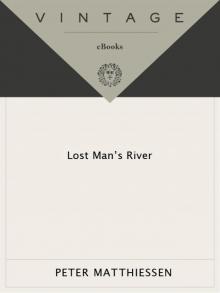 Lost Man's River: Shadow Country Trilogy
Lost Man's River: Shadow Country Trilogy The Tree Where Man Was Born
The Tree Where Man Was Born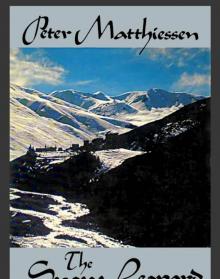 The Snow leopard
The Snow leopard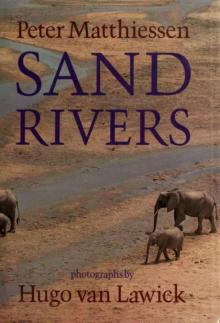 Sand Rivers
Sand Rivers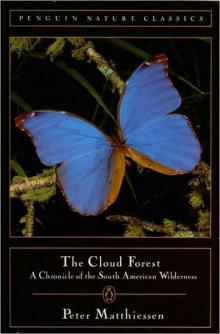 The Cloud Forest
The Cloud Forest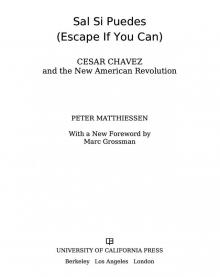 Sal Si Puedes (Escape if You Can)
Sal Si Puedes (Escape if You Can)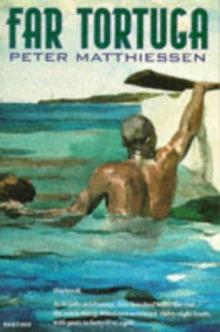 Far Tortuga
Far Tortuga Men's Lives
Men's Lives On the River Styx: And Other Stories
On the River Styx: And Other Stories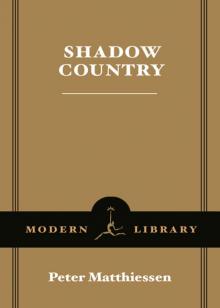 Shadow Country
Shadow Country At Play in the Fields of the Lord
At Play in the Fields of the Lord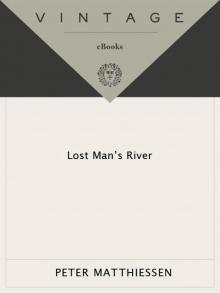 Lost Man's River
Lost Man's River Killing Mister Watson
Killing Mister Watson On the River Styx
On the River Styx